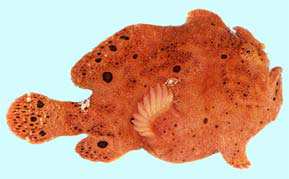ANTENNARIIDAE
Frogfishes
By Hiroyuki Motomura
 Antennarius coccineus |
 Antennarius commerson |
 Antennarius nummifer |
 Antennarius pictus |
|
Small to moderate fishes, largest species attaining to over 50 cm; most species less than 20 cm. Body short, deep, globose, slightly compressed. Mouth large, strongly oblique to vertical; villiform teeth on jaws and palatines. Gill opening, below or behind pectoral-fin base, with a small pore. Dorsal fin with III spines and 10-16 soft rays; spinous portion of fin widely separated from soft-rayed portion; first spine free from rest of fin, nearly always with a well-developed terminal bait (esca); second and third spines covered by thick skin. Anal fin with 6-10 soft rays. Caudal fin rounded. Pectoral fin with 6-14 rays, elongate, leg-like. Pelvic fin with I spine and 5 soft rays. Body covered with loose skin, naked or with denticles. Color: extremely variable, often closely matching that of surroundings; changing color within a few weeks in some species. Similar families occurring in the area. Families with an esca not occur in shore waters in the area. Remarks. Most species inhabiting on bottom in shallow waters; one species pelagic, clinging in floating algae. Feeds on fishes, sometimes large fishes longer than themselves; also cannibalistic. Released eggs embedded in a single, large, buoyant gelatinous mass; floating on water surface. |

|
|